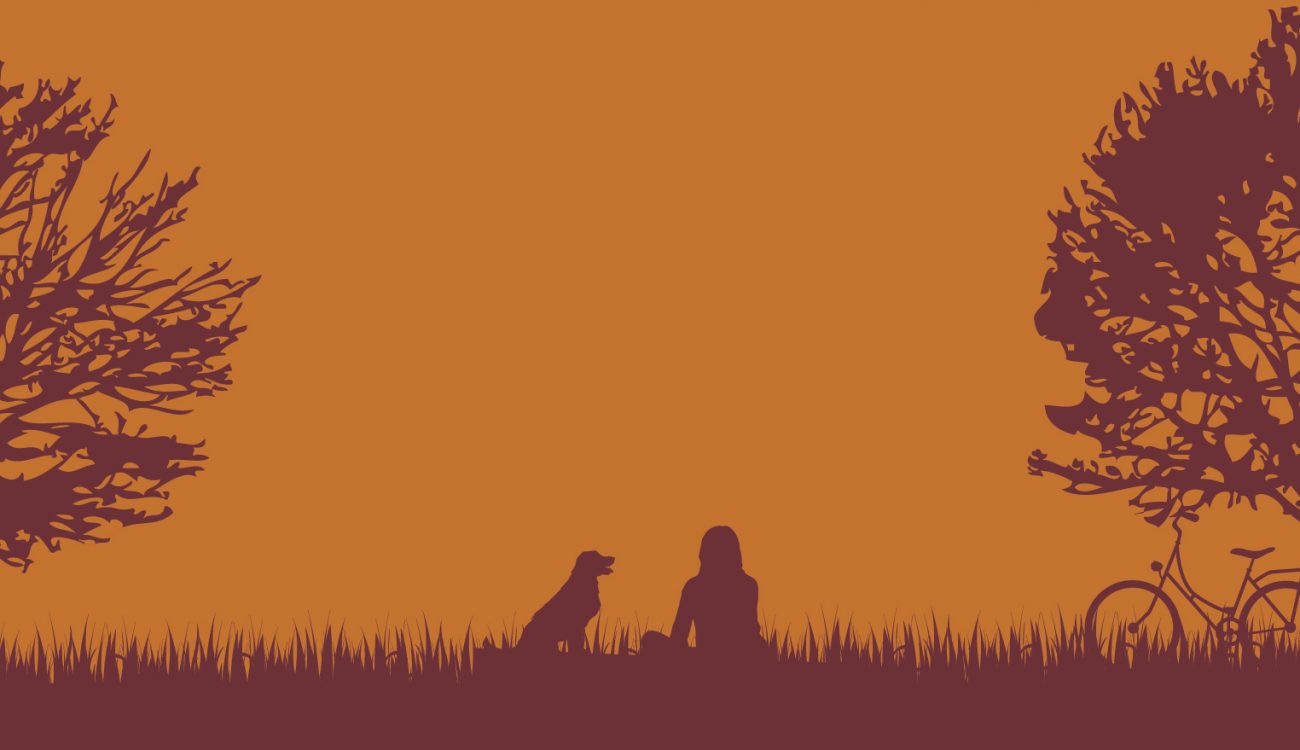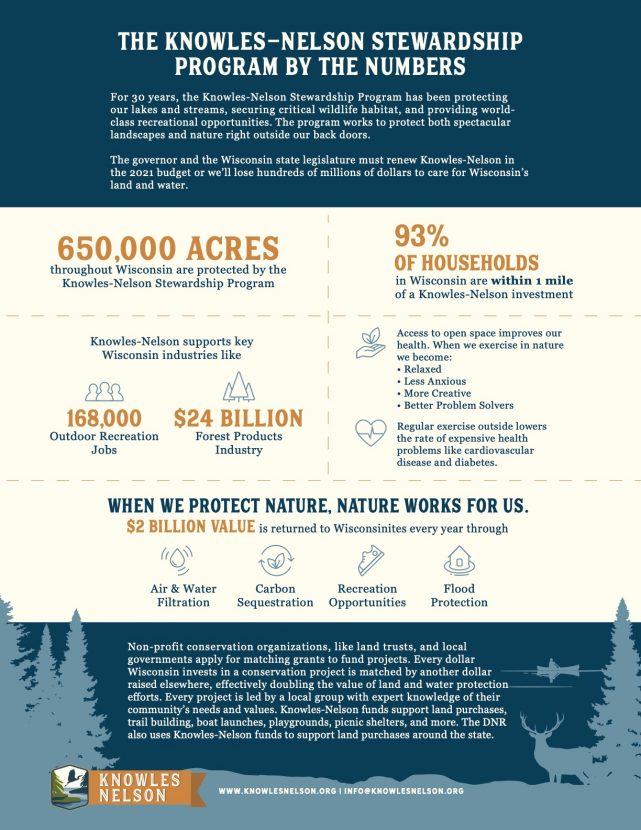
Everyone Benefits from the Knowles-Nelson Program
The Knowles-Nelson Stewardship Program proves its worth
The Knowles-Nelson Stewardship Program proves its worth
Wisconsin’s most successful environmental conservation program is also one of the state’s best kept secrets. The Knowles-Nelson Stewardship Program works behind the scenes to provide grants to local governments and nonprofits to build bike trails, campgrounds, develop trailheads, purchase parkland and so much more. The Wisconsin Department of Natural Resources uses the program for all those reasons, too.
Support for developing Wisconsin’s recreation infrastructure and protecting our land and water resources is at an all-time high. Recent polling shows that more than nine in 10 Wisconsinites support increased funding for recreation and conservation. More than two-thirds of those polled — Republicans and Democrats — said they have a more favorable view of legislators who support environmental conservation and outdoor recreation.
Knowles-Nelson, however, has had a rough go in the Legislature over the past several years. In 2007, the program received $87 million in funding. That amount has been cut in nearly every state budget since. At the beginning of 2021, Knowles-Nelson received just $33 million, despite the fact that demand for conservation and recreation investments is higher than ever.
Team Knowles-Nelson — a remarkably diverse coalition of bikers, hikers, conservationists, birdwatchers, hunters, business owners, local governments and others — have come together to organize and fight for the Knowles-Nelson Stewardship Program. Check out KnowlesNelson.org to join the team and learn about all their work on behalf of the beautiful places that make Wisconsin special.
Knowles-Nelson and Bikes
More than 1,500 Knowles-Nelson grants have been awarded to nonprofits and local governments for trail building, trailheads, parks, shelters, restrooms and more. The paths that many of us use to commute to work every day, as well as the places where we get away on the weekends, are sustained by Knowles-Nelson funding. Just a few of the bike projects funded by the program include:
- Capital City State Trail – Dane County
- Nine Mile County Forest – Marathon County
- Oak Leaf Trail – Milwaukee
- The Elroy-Sparta State Trail – The nation’s first rail trail
- Great Headwaters Trail – Vilas County
- Loop the Little Lake – Neenah and Menasha
- Great River State Trail – La Crosse
And so many more. If you’re curious to see where Knowles-Nelson money has been put to work in your community, have a look at the interactive map Team Knowles-Nelson put together at Map.KnowlesNelson.org.
History of the Stewardship Program
For 30 years, Knowles-Nelson has provided funds to build trails and campgrounds, buy land for parks and protect Wisconsin’s iconic landscapes. Named after two former Wisconsin governors — Warren Knowles, a Republican, and Gaylord Nelson, a Democrat — the Knowles-Nelson Stewardship Program honors Wisconsin’s bipartisan commitment to land and water protection.
Iconic landscapes, like the Lower Wisconsin River, old growth hemlock stands and vast working forests in the Northwoods and hundreds of spots throughout Door County, have all been protected with Knowles-Nelson dollars.
But the program also helps us pay for the places where we seek and find respite. Neighborhood parks and trails, baseball fields and the pavilions that host local farmers markets also exist because of Knowles-Nelson dollars.
More than 90% of Wisconsin households are within one mile of a Knowles-Nelson investment. Your neighborhood park, the bike trail you ride on every day and your favorite camping spot have likely all benefited from a Knowles-Nelson grant. And the program only costs each of us about $19.75 per year. That’s less than a state park pass, a local trail pass or the cost of going out to eat after a big ride.

An Impressive Return on Investment
The Knowles-Nelson Stewardship Program is an investment in Wisconsin’s natural infrastructure. Our land and water are the basic foundation that supports Wisconsinites’ lives and our economy. And when we protect nature, nature works for us. Trees filter the air, sequester carbon and provide shade on hot, sunny days. Grasslands store immense amounts of carbon in their roots deep beneath the soil. Wetlands protect our communities from floods and filter our drinking water. Beautiful views soothe the soul. And healthy ecosystems support diverse wildlife populations.
Placing a dollar value on nature’s work is challenging because the products of that labor are not bought and sold like lumber, energy or agricultural goods. But scientists have been hard at work doing just that, quantifying the value of nature’s work. Recent research on the value of Knowles-Nelson lands shows that the 650,000 acres protected by Knowles-Nelson dollars return more than $2 billion to Wisconsin annually. And nature will continue to work for us as long as we protect it’s basic integrity.
The trails, campgrounds and boat launches funded by Knowles-Nelson are also essential infrastructure. The COVID-19 pandemic has made it clear just how much we value getting outside, riding our bikes and enjoying Wisconsin’s beauty. Purchases of state park stickers are through the roof, trail counters show huge jumps in traffic, and every bike shop owner can tell you how hard it was to keep bikes in stock last year. But we all need places to ride and play.
That’s where Knowles-Nelson comes in. A grant from the state is often the first piece of the puzzle in funding a new portion of trail. That state money can then be matched with federal grants, money from local governments and donations from passionate and generous individuals. Every single one of those 1,500 Knowles-Nelson grants to local governments has a story behind it that includes planning, organizing, fundraising and eventually celebrating a new success.
Where to Go From Here
A major debate about the future of the program has been playing out in the state Legislature. In February, Gov. Tony Evers proposed renewing the program for 10 years and more than doubling its funding to $70 million per year. Visit KnowlesNelson.org for the latest news on the debate and the future of the program.
As cyclists, we’re all activists and community builders, too. Bike lanes, singletrack networks and paths on converted rail corridors don’t appear magically. They’re all the result of the hard work of countless people who advocate for bikes with government officials, build community with like-minded folks and build consensus with those who aren’t bikers but share our love for Wisconsin’s natural places.
Once we’re sure that the future of Knowles-Nelson is secure, we can focus on improving the program and supporting all the nonprofits and local governments that work so hard to build and maintain our trails.
Visit Research.KnowlesNelson.org. It’s a treasure trove of information on how the program works, where money is invested and the benefits we all receive from Wisconsin’s most successful environmental conservation program.
Finally, make sure to tell a friend about Knowles-Nelson. The more people who know about how our trails, parks and wild places get built and protected, the better.